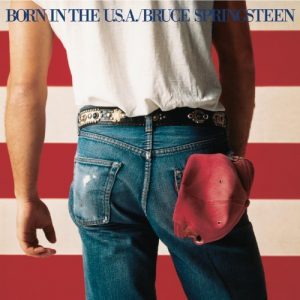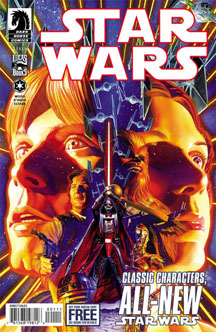As proven earlier this year when Marvel’s relaunch of the saga broke sales records, Issue No. 1s of series simply titled “Star Wars” draw a lot of interest. They also cause confusion for organizational purposes, as there are now four series by that name. The series that started in 1977 has traditionally been called Marvel “Star Wars,” but now we’ll have to call it Marvel Volume 1, with the 2015 series called Marvel Volume 2. Dark Horse’s 1998 series was retitled “Republic” during its run, so that’s what we call it. And I propose calling Dark Horse’s 2013-14 series Brian Wood’s “Star Wars,” since he wrote all 20 issues.
While Marvel Volume 2 is a true reboot, as part of the Lucasfilm Story Group’s new canon, the Wood series was rumored to be a reboot of the continuity. Thankfully, this turned out not to be the case, so we can enjoy connections to other stories and the challenge of fitting it into the Legends timeline. It’s probably impossible, as we’re told this series starts five months after the Battle of Yavin, yet Vader knows the name Skywalker, thus placing it after “Vader’s Quest” and Marvel Volume 1 Issue 35, which seem to take place much more than five months into the three-year span between “A New Hope” and “The Empire Strikes Back.”
Additionally, Wedge invents the name Rogue Squadron here, placing this series after all the stories where his group was called Red Squadron – notably the “Empire”/“Rebellion” series (which mistakenly uses “Rogue” at times, but “Red” predominates).
Also, the second Death Star is being constructed during this time – and it looks almost as far along as it will in “Return of the Jedi,” suggesting placement further away from the Battle of Yavin.
Despite the proliferation of stories set between the Battles of Yavin and Hoth, Issues 1-12 (2013) of Wood’s “Star Wars” add a surprising amount of rich material. Some of it feels familiar, such as Han and Chewie going on a weapons-procurement mission where they meet up with a cute garbage-scow operator named Perla and get chased by Boba Fett and Bossk. Han notes that this is his first return to Coruscant since he was in the Imperial Academy in the “Han Solo Trilogy.” Luke goes through his paces as a budding Jedi and a hotshot pilot (a little too hot, because at one point Leia suspends him from Stealth Squadron!), and adds another almost-love-interest to his tally with the Chalactan cutie Prithi, who has a touch of Force potential.
Wood gives attention to two characters who had previously been overlooked during this time period. One is Mon Mothma, the Rebellion’s strategist. The other is Wedge Antilles, who is part of Leia’s Stealth Squadron. I love the fact that Wedge mentions Mala Tinero to Luke when they reminisce while hiding in a Star Destroyer ventilation shaft. Mala was Wedge’s love interest in Rob Williams’ short story “Lucky” in “Star Wars Tales” Issue 23, so Wood brings that Infinities story into Legends. (Incidentally, I hope the LSG canon similarly incorporates some Legends elements.) Wedge never mentions Mala in Michael Stackpole’s “Rogue Squadron” series, but it seems fitting that Luke is the friend he opens up to.

The real eye-opener in Wood’s “Star Wars” is Leia. The author does a masterful job of balancing Leia’s dual roles as leader and warrior. In “A New Hope,” she was a warrior on the Death Star, then a leader during the Battle of Yavin. In Marvel Volume 1 and the Goodwin/Williamson strips, she leaned toward leader, and in “Empire”/”Rebellion,” she leaned toward warrior. Here, she is both – she leads the missions to find a new Rebel base, but flies an X-wing herself. Yet Wood doesn’t make her a better pilot than Wedge or Luke; indeed, her X-wing gets pretty banged-up on these missions, like her Y-wing in “Splinter of the Mind’s Eye” — but it’s safe to say Alan Dean Foster’s meek Leia is not the accepted portrayal anymore. Wood doesn’t make Leia superhuman, though: At various points, she shows jealousy toward Prithi and Perla.
Boosted by vibrant art from Carlos D’Anda (pencils and inks, Issues 1-6, 10-12), Ryan Kelly (pencils, 7-9), Dan Parsons (inks, 7-9) and Gabe Eltaeb (colors), Wood’s “Star Wars” unfolds like a novel. This is partly a bad thing, because the story moves slower than most comics.
But I generally mean it in a good way. We are privy to Leia’s thoughts as she mourns Alderaan. She comes across Tag Rogaren, the weapons systems engineer, who maintains a vigil in the graveyard of rocks where the planet used to be. Rogaren is something like the 100th different person involved with the construction of the first Death Star in the EU; I expect “Rebels” will streamline the process a bit, perhaps building upon the giant Kyber crystal from “The Clone Wars’ ” “Crystal Crisis on Utapau” arc.
While Wood isn’t strictly interested in showing off the major linkages between Episodes IV and V (since things like the bounty hunter of Ord Mantell and the discovery of Hoth have been thoroughly covered), these issues do feel similar to Timothy Zahn’s “Thrawn Trilogy” and Steve Perry’s “Shadows of the Empire” in that we return to familiar people and locations. I love it when Luke and Leia stop by the old Lars homestead and Luke apologizes to his aunt’s and uncle’s graves for being a bad son.
I know Marvel Volume 2 is the “official” chronicle of our heroes during this time and Wood’s “Star Wars” is “merely” Legends. But it sure feels like a proper continuation of the saga and sets the bar high.

